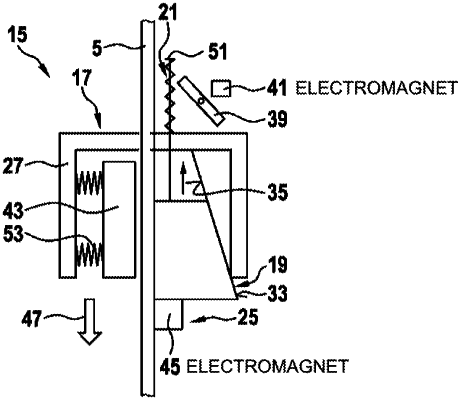| CPC B66B 5/22 (2013.01) | 16 Claims |

|
1. A brake device for braking a traveling body of an elevator system, the traveling body being movable in a guided manner along a guide rail in a movement direction, the brake device comprising:
a holder adapted to be attached to the traveling body;
a brake element;
a pretensioning element;
a release element;
a pressing element;
wherein the brake element is held and mounted on the holder and has a brake surface directed toward the guide rail when the holder is attached to the traveling body, the brake element being movable relative to the holder between a free-running position and a braking position, wherein the brake surface is spaced laterally apart from the guide rail in the free-running position and is pressed laterally against the guide rail in the braking position;
wherein the pretensioning element, in a deactivated configuration, does not exert a force on the brake element to move the brake element toward the braking position and, in an activated configuration, exerts a force on the brake element that moves the brake element toward the braking position;
wherein the release element holds the pretensioning element in a holding state and, when the release element is activated into a released state, reconfigures the pretensioning element from the deactivated configuration into the activated configuration; and
wherein the pressing element, in an unactuated state, does not generate a force on the brake element in a direction oriented toward the guide rail and, in an actuated state, generates a force on the brake element in a direction oriented toward the guide rail.
|